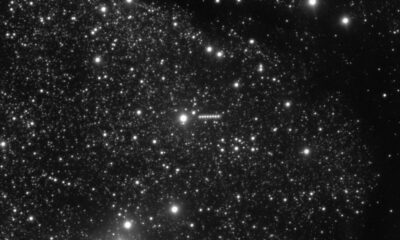Science
Scientists Trace Origins of Moon-Forming Planet Theia to Inner Solar System

A recent analysis has revealed that Theia, the long-lost planet believed to have played a crucial role in the formation of the Moon, likely originated from the inner Solar System. This finding challenges previous assumptions about the planet’s location before it collided with Earth approximately 4.5 billion years ago.
The hypothesis surrounding Theia posits that it collided with early Earth, resulting in debris that eventually formed the Moon. For decades, this theory, known as the giant impact theory, has been the prevailing explanation for the Moon’s creation, but the absence of direct chemical evidence has made it difficult to confirm Theia’s exact origin and composition.
Analysis of Ancient Rocks Reveals New Insights
A team of astronomers from France, Germany, and the United States conducted a comprehensive analysis using ancient lunar and terrestrial rocks. Their research involved examining isotopes, which are chemical fingerprints that can provide insights into the history of celestial bodies.
Jake Foster, an astronomer at the Royal Observatory Greenwich in the UK, commented on the significance of the findings: “One of the things about this research that does make it so exciting is not only is it helping to paint a picture of what happened to the Earth four and a half billion years ago, but also it’s able to almost exactly pinpoint where this object came from.”
The research team embarked on a process referred to as planetary reverse engineering. By studying isotopes of elements such as iron, chromium, zirconium, and molybdenum, they modeled hundreds of scenarios to determine the possible origins of Theia.
New Findings Challenge Previous Theories
The results indicated that materials closer to the Sun, like Theia, formed under different temperatures and conditions than those further out in the Solar System. By comparing isotope patterns across various regions, researchers concluded that Theia most likely existed even closer to the Sun than early Earth, contradicting some earlier theories that suggested it formed in the outer Solar System.
The study’s findings could pave the way for future research into the growth, collisions, and evolution of planets in the early stages of solar systems. Understanding Theia’s origins not only sheds light on the history of the Moon but also enhances our understanding of planetary formation in general.
As scientists continue to analyze the data collected from both lunar samples and terrestrial rocks, the hope is that this research will contribute significantly to our knowledge of how celestial bodies interact and evolve over billions of years.
-

 World5 days ago
World5 days agoCoronation Street’s Shocking Murder Twist Reveals Family Secrets
-

 Entertainment4 months ago
Entertainment4 months agoKate Garraway Sells £2 Million Home Amid Financial Struggles
-

 Entertainment3 months ago
Entertainment3 months agoAnn Ming Reflects on ITV’s ‘I Fought the Law’ Drama
-

 Entertainment3 days ago
Entertainment3 days agoAndrew Pierce Confirms Departure from ITV’s Good Morning Britain
-

 Health3 months ago
Health3 months agoKatie Price Faces New Health Concerns After Cancer Symptoms Resurface
-

 Entertainment4 weeks ago
Entertainment4 weeks agoCoronation Street Fans React as Todd Faces Heartbreaking Choice
-

 World4 weeks ago
World4 weeks agoBailey Announces Heartbreaking Split from Rebecca After Reunion
-

 Entertainment1 week ago
Entertainment1 week agoTwo Stars Evicted from I’m A Celebrity Just Days Before Finale
-

 World1 week ago
World1 week agoKevin Sinfield Exceeds Fundraising Goal Ahead of Final Marathons
-

 Entertainment3 months ago
Entertainment3 months agoCoronation Street’s Carl Webster Faces Trouble with New Affairs
-

 Entertainment3 months ago
Entertainment3 months agoWhere is Tinder Swindler Simon Leviev? Latest Updates Revealed
-

 Entertainment4 months ago
Entertainment4 months agoMarkiplier Addresses AI Controversy During Livestream Response




















